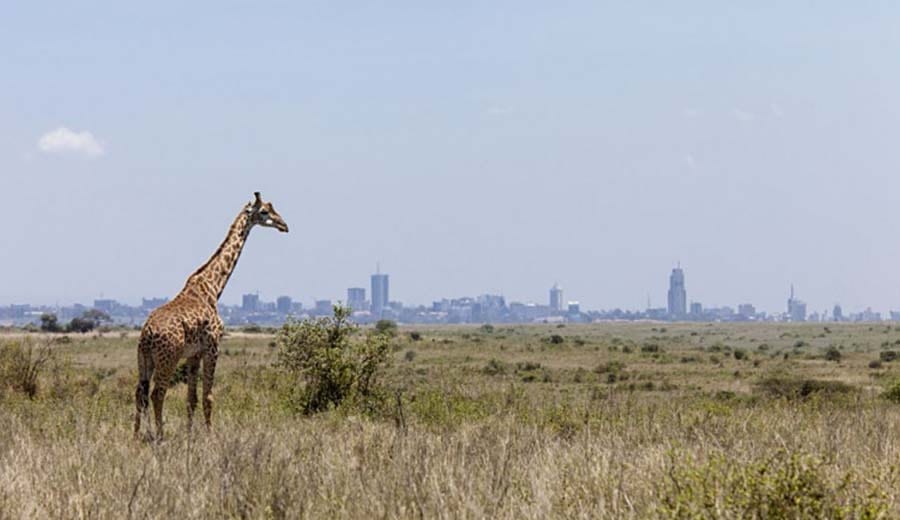Nairobi National Park
Nairobi National Park – A must-visit for all wildlife lovers!
Introduction
Nairobi National Park is the largest and first national park in Kenya established in 1946. It is located approximately 7 kilometers from the center of Nairobi toward the south (Kenya’s capital city) with an electric fence separating the park’s wildlife from human beings. The short range of urban and natural environments has caused problems between the animals and local people and caused a disturbance in animals’ migration routes.
Still, despite its short range of civilization and relatively small size for an African national park, Nairobi National Park has an extensive wildlife collection. Migrating herbivores gather in the park during summer and it is one of Kenya’s most useful rhinoceros sanctuaries.
Flora – Nairobi National Park
The park’s predominant environment is open grass plain with scattering Acacia bushes. Here in the dry highland forest, you can see:
- Olea Africana,
- Croton dichogamous,
- Brachylaenahutchinsii,
- Calodendrum
The lower slopes of these areas are grassland. Digitaria and Cynadon species are found in these lower slopes areas. There are also scattered yellow-barked Acacia xanthophylls found to be very rare. One can find a small substitute of a river rising from the side of the main river inside the park, in the southern region. Acacia as well as Euphorbia candelabrum can be seen predominantly in the valley area in the park.
Fauna – Nairobi National Park
Nairobi national park having a greater and more diverse wildlife species variety found. The variety of creatures that you can hope to see in the Nairobi National Park is:
- Cape buffaloes,
- baboons,
- Eastern black rhinos,
- gazelles,
- zebras,
- Tanzanian cheetahs,
- Coke’s hartebeest,
- hippopotami,
- leopards,
- East African lions,
- elands,
- impala,
- Masai giraffes,
- ostriches,
- vultures
- waterbucks
This park conserves the zebra and wildebeest species. They spread over the plains in the rainy season and return to the park in the summer season. The concentration of wildlife in the park is greatest in the summer season when areas outside the park have dried up and animal has to return. They attract water-dependent herbivores during the summer season. The Nairobi National Park has a high diversity of bird species, with up to 500 -600 permanent and migratory species in the park.
Conservation
This helped to uphold tourism as Kenya’s primary industry. However, it creates problems between the human population and wildlife. Farmers living nearby the parks did not provide input to the parks. Locals received very little help from the game animals. Human beings are threatened by lions, and some landowners think that Kenya’s wildlife is not good for them. In 1948 188,975 people lived in Nairobi, and by 1997 the city’s population had grown to 1.6 million. People live right nearby the park’s boundaries, which creates human-animal conflicts.
Tourism and Education
Nairobi National Park is the main attraction for the visitor main attractions includes the park’s variety of bird species, cheetah, hyena, leopard, black panthers, and lions. The Ivory Burning Site Monument, the Nairobi Safari Walk, and the animal orphanage are some of the must-visit places in this park. Inhabitants of Nairobi visit the park and thousands of Kenyan children and college on field trips visit the park each week.
Nairobi National Park Rules
- Visitors must stay on designated roads and paths to avoid disturbing wildlife.
- Hunting, capturing, or killing wildlife is strictly prohibited.
- Littering, including cigarette butts, is strictly prohibited.
- The use of drones is not allowed.
- Lighting fires is prohibited.
- Visitors are advised to keep a safe distance from wildlife and not to approach them too closely.
- Pets are not allowed within the park.
- Noise pollution, such as loud music, is prohibited.
- Vehicles must be driven at a safe speed and must not exceed 40 km/hr.
- All visitors must abide by the park’s rules and regulations to ensure the safety of both themselves and the wildlife.
Nairobi National Park Activity
- Wildlife viewing: Visitors can see a variety of wildlife, including lions, leopards, rhinos, elephants, and buffalo, among others.
- Game drives: Guided game drives are available to explore the park and see wildlife in their natural habitats.
- Bird watching: The park is home to over 400 species of birds, making it a popular spot for bird watching.
- Picnicking: Visitors can bring food and enjoy a picnic in designated areas.
- Nature walks: Guided nature walks are available to explore the park on foot and learn about its flora and fauna.
- Photography: The park offers ample opportunities for nature and wildlife photography.
- Education and research: The park is also used for educational and research purposes, with various programs and studies taking place.
- Conservation: Nairobi National Park is actively involved in wildlife conservation and preservation efforts, including rhino and elephant conservation programs.
Safari zone and Timing
- Safari Zone: Nairobi National Park is located on the outskirts of Nairobi, Kenya, and covers an area of 117 square kilometers.
- Timing: The park is open every day of the year, including public holidays. The park’s opening hours are from 6:00 AM to 6:00 PM. Visitors are advised to check with park authorities for any changes to the park’s operating hours.
- Best time to visit: The best time to visit the park is during the dry season, which is from July to October, as wildlife tends to congregate around water sources, making them easier to spot. However, wildlife can be seen year-round in the park.



